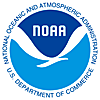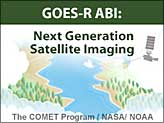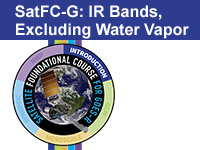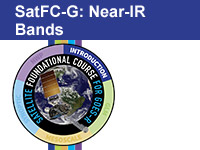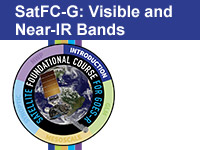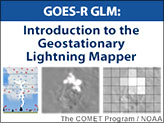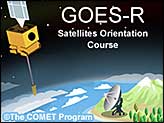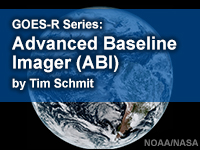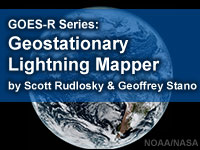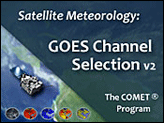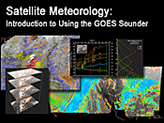Training: Instruments
Click on the thumbnail images or links below to launch/redirect to each training course.
Weather Event Simulator: Advanced Baseline Imager
Cooperative Program for Operational Meteorology, Education, and Training (Comet)
 The Cooperative Program for Operational Meteorology, Education, and Training supports, enhances, and stimulates the communication and application of scientific knowledge of the atmospheric and related sciences for the operational and educational communities. COMET’s web-based self-paced training materials serve earth science education and training needs by providing interactive experiences for learners at a distance. Experts at both the Cooperative Institute for Meteorological Satellite Studies (CIMSS) and the Cooperative Institute for Research in the Atmosphere (CIRA) contributed to many of these lessons.
The Cooperative Program for Operational Meteorology, Education, and Training supports, enhances, and stimulates the communication and application of scientific knowledge of the atmospheric and related sciences for the operational and educational communities. COMET’s web-based self-paced training materials serve earth science education and training needs by providing interactive experiences for learners at a distance. Experts at both the Cooperative Institute for Meteorological Satellite Studies (CIMSS) and the Cooperative Institute for Research in the Atmosphere (CIRA) contributed to many of these lessons.
GOES-R ABI
GOES-R ABI: This extension of the COMET module “GOES-R: Benefits of Next Generation Environmental Monitoring” focuses on the Advanced Baseline Imager (ABI) instrument, the satellite's 16-channel imager. The module introduces ABI's key features and improvements over earlier GOES imagers and lets users interactively explore ABI's 16 channels. It also contains movies that show the advancements that ABI will bring to a variety of applications and contains additional resources. This module is also available in Spanish.
GOES-R ABI IR Bands, Excluding Water Vapor
GOES-R ABI IR Bands, Excluding Water Vapor: This lesson introduces seven of the ten infrared imager bands on the GOES-R Series Advanced Baseline Imager, focusing on their special characteristics and how they affect what each band observes.
GOES-R ABI Near-IR Bands
GOES-R ABI Near-IR Bands: This less introduces three of the four near-infrared imager bands (at 1.37, 1.6, and 2.2 micrometers) on the GOES-R Series Advanced Baseline Imager, focusing on their special characteristics and how they affect what each band observes.
GOES-R ABI Visible and Near-IR Bands
GOES-R ABI Visible and Near-IR Bands: This lesson introduces the two visible and one near-infrared imager bands on the GOES-R Series Advanced Baseline Imager, focusing on their special characteristics and how they affect what each band observes.
GOES-R GLM: Introduction to the Geostationary Lightning Mapper
GOES-R GLM: Introduction to the Geostationary Lightning Mapper: This extension of the COMET module "GOES-R: Benefits of Next Generation Environmental Monitoring" focuses on the Geostationary Lightning Mapper (GLM) instrument. GLM provides continuous lightning measurements over a large portion of the Western Hemisphere, mapping total lightning (intra-cloud and cloud–to–ground) flash rates and trends. This module is also available in Spanish.
GOES-R Satellites Orientation Course
GOES-R Satellites Orientation Course: This course consists of three self-paced lessons, “GOES-R: Benefits of Next-Generation Environmental Monitoring,” “GOES-R ABI: Next Generation Satellite Imaging,” and “GOES-R GLM: Introduction to the Geostationary Lightning Mapper,” that introduces forecasters, students, researchers and other interested learners to the capabilities, products and applications anticipated with the next-generation GOES-R satellites. This module is also available in Spanish.
GOES-R Series Faculty Virtual Course: Advanced Baseline Imager
GOES-R Series Faculty Virtual Course: Advanced Baseline Imager: This course is part of a webinar series to provide university faculty and others with a solid basis for using GOES-R/16 data in coursework and student research projects. This module highlights the improved temporal, spatial, spectral and calibration attributes of the Advanced Baseline Imager (ABI) on the GOES-R Series.
GOES-R Series Faculty Virtual Course: Geostationary Lightning Mapper
GOES-R Series Faculty Virtual Course: Geostationary Lightning Mapper: This course is part of a webinar series to provide university faculty and others with a solid basis for using GOES-R/16 data in coursework and student research projects. This module highlights the capabilities of the GOES-R/16 Geostationary Lightning Mapper (GLM) in both operational and research applications and how the GLM differs from land-based lightning detection.
Satellite Meteorology: GOES Channel Selection Version 2
Satellite Meteorology: GOES Channel Selection Version 2: This module includes significant updates to the module "Satellite Meteorology: GOES Channel Selection." It still reviews the five GOES imager channels and their use, incorporating updated technical information, conceptual visualizations and numerous imagery examples. This module is also available in Spanish.
Satellite Meteorology: Introduction to Using the GOES Sounder
Satellite Meteorology: Introduction to Using the GOES Sounder: This module, adapted for the Web from the CD-ROM released in 1998, reviews GOES sounder characteristics, data products, and applications concurrent with the GOES I(8)-P satellites. This module is also available in Spanish.
Virtual Institute for Satellite Integration Training (VISIT)
 Virtual Institute for Satellite Integration Training (VISIT) is a joint effort involving NOAA Cooperative Institutes, the National Environmental Satellite Data and Information Service (NESDIS), and the National Weather Service (NWS). The primary mission of VISIT is to accelerate the transfer of research results based on atmospheric remote sensing data into NWS operations using distance education techniques. Training sessions include topics on satellite meteorology, severe weather, climate, numerical weather prediction, and more.
Many of these modules were developed in collaboration with the Cooperative Institute for Meteorological Satellite Studies (CIMSS) and the Cooperative Institute for Research in the Atmosphere (CIRA). VISIT also provides satellite chats to demonstrate satellite products that can be applied to operational forecasting and identify new training topics based on specific participant needs. See the VISIT Training Calendar for upcoming teletraining sessions.
Virtual Institute for Satellite Integration Training (VISIT) is a joint effort involving NOAA Cooperative Institutes, the National Environmental Satellite Data and Information Service (NESDIS), and the National Weather Service (NWS). The primary mission of VISIT is to accelerate the transfer of research results based on atmospheric remote sensing data into NWS operations using distance education techniques. Training sessions include topics on satellite meteorology, severe weather, climate, numerical weather prediction, and more.
Many of these modules were developed in collaboration with the Cooperative Institute for Meteorological Satellite Studies (CIMSS) and the Cooperative Institute for Research in the Atmosphere (CIRA). VISIT also provides satellite chats to demonstrate satellite products that can be applied to operational forecasting and identify new training topics based on specific participant needs. See the VISIT Training Calendar for upcoming teletraining sessions.
VISIT Training Sessions:
VISIT offers a wide selection of satellite remote sensing training materials. See the VISIT Training Sessions webpage for a complete listing.
FDTD Satellite Application Webinars:
The National Weather Service Forecast Decision Training Division (FDTD) Satellite Application Webinars are peer-to-peer learning; staff from Weather Forecast Offices (WFOs), National Centers, Center Weather Service Units (CWSUs), and River Forecast Centers (RFCs) lead the presentations. The webinars to share how to apply GOES imagery with other datasets for a specific operational application.



